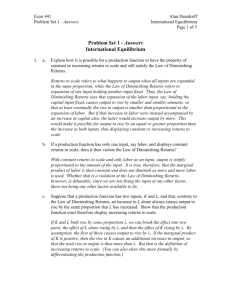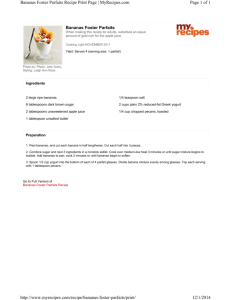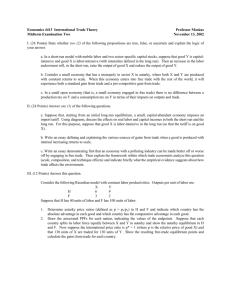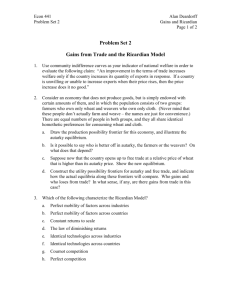set4a
advertisement
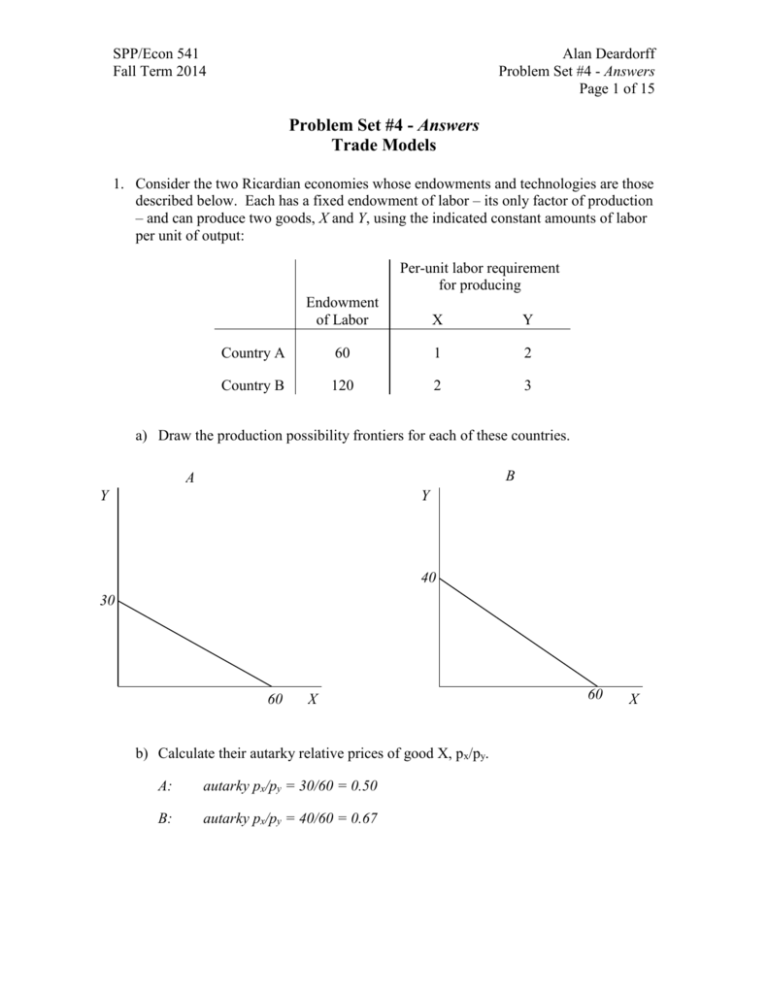
SPP/Econ 541 Fall Term 2014 Alan Deardorff Problem Set #4 - Answers Page 1 of 15 Problem Set #4 - Answers Trade Models 1. Consider the two Ricardian economies whose endowments and technologies are those described below. Each has a fixed endowment of labor – its only factor of production – and can produce two goods, X and Y, using the indicated constant amounts of labor per unit of output: Per-unit labor requirement for producing Endowment of Labor X Y Country A 60 1 2 Country B 120 2 3 a) Draw the production possibility frontiers for each of these countries. B A Y Y 40 30 60 X b) Calculate their autarky relative prices of good X, px/py. A: autarky px/py = 30/60 = 0.50 B: autarky px/py = 40/60 = 0.67 60 X SPP/Econ 541 Fall Term 2014 Alan Deardorff Problem Set #4 - Answers Page 2 of 15 c) Which country has an absolute advantage in good X? Which in good Y? Which has a comparative advantage in good X? Which in good Y? Absolute advantage in X: A Absolute advantage in Y: A Comparative advantage in X: A Comparative advantage in Y: B d) What are the autarky wages of workers in country A, in units of good X per unit of labor? In units of good Y per unit of labor? What are the autarky wages of workers in country B, also in units of good X and in units of good Y? Can you tell which country’s workers are better off in autarky? Autarky wages in units of the goods are just the reciprocals of the respective unit labor requirements: A: w/pX (in units of X) = 1.0 w/pY (in units of Y) = 0.5 B: w/pX (in units of X) = 0.5 w/pY (in units of Y) = 0.33 A’s workers are better off because they can consume more of both goods. e) Suppose now that free trade between these countries leads to a world equilibrium price of px/py = 0.60. Calculate the new wages of labor in each country in units of both X and Y. Are these workers better off, worse off, the same, or is it impossible to tell? At this price, which is strictly between the two autarky prices, the countries both completely specialize in the good in which they have comparative advantage, A in X and B in Y. In units of the good that they still produce, wages are the same as in autarky: A: wA/pX = 1/aLX = 1/1 = 1.0 B: wB/pY = 1/aLY* = 1/3 = 0.33 In units of the good they don’t produce, wages depend on the price ratio, as follows: A: wA/pY = (wA/pX )(pX/pY) = (1.0)(0.60) = 0.60 SPP/Econ 541 Fall Term 2014 B: Alan Deardorff Problem Set #4 - Answers Page 3 of 15 wB/pX = (wB/pY )/(pX/pY) = (0.33)/(0.60) = 0.55 Comparing these to the autarky wages in part (d), A’s workers are better off because they can buy the same amount of X and more Y (0.60 vs. 0.50), and B’s workers are also better off because they can buy the same amount of Y and more X (0.55 vs. 0.5). f) Suppose instead that these two countries are not the only countries in the world, but that they actually both trade with a much larger world, in which the relative price of the two goods takes on the four different values listed below. For each price, indicate which good each country will export (“X”, “Y”, “0” if neither, and “?” if it is ambiguous). A B px/py = 0.4 Y Y px/py = 0.5 ? Y px/py = 0.6 X Y px/py = 0.7 X X Notes: Since they are trading with a larger world, there is now no need for these two countries to export and import different goods. When the world price of a good is below their autarky price, they will import it and not produce it; when it is above they will produce only it and export it, as the table shows. A special case is px/py = 0.5, which is the same as country A’s autarky price. At that price, producers are indifferent between producing X and Y, since they break even on both. If they were trading only with country B, which imports X at that price, A would have to export it. But trading with the larger world, A can produce more, less, or the same as its own consumers demand, and its direction of trade is ambiguous. SPP/Econ 541 Fall Term 2014 Alan Deardorff Problem Set #4 - Answers Page 4 of 15 2. Using a Ricardian Model in which France and Britain have comparative advantages in croissants and crumpets respectively, work out the effects in both countries on the world relative price of croissants, and also on real wages in both countries, of the following changes (one at a time). Assume that in the initial equilibrium, both countries are completely specialized. The initial equilibrium is an intersection of relative supply and demand as shown below. The relative supply curve of croissants, RS, starts at the French autarky price, F F ~ pF ~ pcro /~ pcru and is flat out to the ratio of French maximum croissant output, F F B B , to British maximum crumpet output, Xˆ cru . It is then Xˆ cro LF / acro LB / acru pB ~ pB / ~ p B , at which it is again vertical. vertical up to the British autarky price, ~ cro cru Since the initial equilibrium has both countries completely specialized, the downward sloping relative demand curve, RD, must intersect the relative supply curve in its vertical portion. a) The labor supply in France expands. France can now produce more croissants, shifting the RS curve to the right, to a position like one of the two shown below as RS’ and RS’’ in the figure on the next page. The equilibrium relative price of croissants falls. French workers are worse off, because they are paid the same wage in terms of croissants, but these will now buy fewer crumpets. British workers are better off because they can buy more croissants. SPP/Econ 541 Fall Term 2014 Alan Deardorff Problem Set #4 - Answers Page 5 of 15 b) The British technology for producing croissants improves, but not enough to reverse comparative advantage. This means that the British cost, and thus autarky price, of croissants is reduced, reducing ~ p B . It does not change Britain’s maximum output of crumpets, however, so Xˆ F / Xˆ B is unchanged. Thus the upper horizontal cro cru portion of the RS curve shifts down to one of the positions shown as RS’ and RS’’ above. In the first case, the world equilibrium relative price is unchanged, while in the second it falls. French workers are therefore made worse off only in the second case. Likewise, British workers gain only in the second case, since in the first case they do not actually use the new technology even though it is available. SPP/Econ 541 Fall Term 2014 Alan Deardorff Problem Set #4 - Answers Page 6 of 15 c) The French technology for producing croissants improves. Here it is the French relative autarky price that falls, but it is also true F B that they can produce more croissants, so Xˆ cro rises. Both of these changes / Xˆ cru are of the same size, in percentage terms, but this is not enough to tell us how the world equilibrium will be affected. This depends in part on how much demand for croissants rises with a drop in its price. Two possibilities are shown below, again as RS’ and RS’’. In both cases, the relative world price of croissants falls, benefiting British workers. French workers are also likely to gain, especially if they like to eat croissants, since their wage in units of croissants rises with their productivity. However, the drop in their price means that their wage may fall (but need not) in terms of crumpets. 3. All of the following statements refer to the standard Heckscher-Ohlin Model, with 2 factors (labor and land), 2 goods, and 2 countries. There are, as always in that model, constant returns to scale. Answer briefly whether and why each of the statements is either true or false: a) If the price of labor falls relative to the price of land, then both industries will change to using more labor-intensive techniques of production. True, if the technologies permit any substitution of labor for land. Since the model has both factors perfectly mobile between sectors, the wage is the same in both, as is the rent on land. As the relative wage falls, the cost-minimizing combinations of inputs change in both industries in the same direction, requiring that they both use a higher ratio of labor to land. This is possible, despite unchanged aggregate endowments of labor and land, because the labor-intensive sector shrinks while the land-intensive sector expands. SPP/Econ 541 Fall Term 2014 Alan Deardorff Problem Set #4 - Answers Page 7 of 15 b) Considering a country where land earns more than labor, then if both factor endowments increase in the same proportion, the output of the land-intensive good will increase by more (in percentage terms) than the output of the laborintensive good. False. The relative earnings of land and labor are irrelevant. If prices of goods do not change, then a proportional expansion of both factor endowments will cause the country to increase outputs of both goods in the same proportion. If prices do change, then the change in outputs will depends on the change in prices. The outcome stated above could happen, if the country was initially an exporter of the labor-intensive good, so that its growth pushes down the world price of that good and thus stimulates production of the land-intensive good. But the opposite would happen if the country were initially an exporter of the other good. And the total earnings of land and labor don’t tell us anything about that. c) If the relative price of the labor-intensive good rises, then the wage of labor will rise in the labor-intensive sector and fall in the land-intensive sector. False. The model assumes that labor is perfectly mobile between sectors, and thus that it is paid the same wage in both. Thus if it rises in one, it must also rise in the other. And in fact, by the Stolper-Samuelson Theorem, in this case the real wage will rise in both sectors. d) If both countries are relatively well endowed with land compared to labor, then the relative price of the land-intensive good will rise in both countries when they open to trade with (only) each other. False. If they trade only with each other, then what matters for trade is their relative factor endowments compared to each other, so it is not possible for both to be “relatively well endowed with land compared to labor”, since that would require each to have a high ratio of land to labor than the other. If they do trade with (only) each other, then as always in the Standard Model, the relative price must rise in one and fall in the other in order to induce them to export different goods. (If these were two among many countries that opened to trade with the larger world, then both could be relatively well endowed with the same factor compared to that larger world, and this statement would be true.) e) With free trade, if both countries continue to produce both goods, then workers in the country with more land will be paid the same wage as workers in the other country. True. This is just one implication of Factor Price Equalization. SPP/Econ 541 Fall Term 2014 Alan Deardorff Problem Set #4 - Answers Page 8 of 15 4. Using the Standard Trade Model in which the two goods are bananas and apricots, and the two countries are Moldova and Iceland with Iceland initially exporting bananas to Moldova, work out the effects of the following changes on i) the international relative price of bananas, and ii) the outputs of both goods in both countries. For some of these you may find that some answers are ambiguous, and you should say so, and explain why. The figures below show an initial equilibrium in the Standard Model, with Iceland producing QBI0 of bananas, etc. at the initial equilibrium world relative price of bananas, RP0. The heavy arrows show the net exports of each country. Iceland Moldova SPP/Econ 541 Fall Term 2014 Alan Deardorff Problem Set #4 - Answers Page 9 of 15 a) A shift in consumer preferences in both countries in favor of apricots. The shift of preferences moves both families of indifference curves up and to the left, causing relative demand for bananas to fall in both countries. The relative supply and demand diagram shows that the new equilibrium relative price of bananas is reduced. In the separate PPF diagrams for the two countries, both reduce their outputs of bananas and increase their outputs of apricots. Iceland Moldova b) A technological improvement that increases, for any given allocation of resources, the output of bananas in Iceland by 20%. This shifts the PPF of Iceland to the right by 20%, as shown below. At the initial price, Iceland produces more bananas and fewer apricots, while (with homothetic preferences) it increases its demand for both goods in the same proportion. So the relative supply curve shifts right, as shown in the bottom panel. This causes SPP/Econ 541 Fall Term 2014 Alan Deardorff Problem Set #4 - Answers Page 10 of 15 the equilibrium relative price of bananas to fall to RP1. In both countries, therefore, the price line flattens to the position shown in green. In Moldova, output of bananas falls and output of apricots rises. In Iceland, output of apricots may rise or fall. If the fall in price of bananas is small enough, then the output of apricots will remain below its initial level, as it would be if price did not fall at all. But if the price fall is larger, the output of apricots will rise. Output of bananas in Iceland must rise above its initial level, since the increase in income together with the fall in price assure that world demand for bananas rises. Since output of bananas falls in Moldova, that increase in demand can be met only by a rise in output in Iceland. Iceland Moldova c) Same as (b), but the technological improvement in producing bananas occurs in both countries. SPP/Econ 541 Fall Term 2014 Alan Deardorff Problem Set #4 - Answers Page 11 of 15 I won’t draw this, since the picture is much like (b) except that the PPF of Moldova expands to the right in the same way as the PPF of Iceland. The price drop is larger, however, and as a result the output of bananas may fall in either country, though not both, and the output of apricots can rise or fall in both. d) A prohibitive tariff (i.e., one that reduces imports to zero) levied by Moldova. This is simple, since it pushes both countries to autarky, as shown below. Price of bananas falls in Iceland and rises in Moldova. Output of bananas does the same, while output of apricots does the opposite. Iceland Moldova SPP/Econ 541 Fall Term 2014 Alan Deardorff Problem Set #4 - Answers Page 12 of 15 5. In the situation of Krugman, Obstfeld, and Melitz’s Figure 7-5 (p. 148), what will happen to the price on the world market if Thailand pursues each of the following policies? I’ll use the additional labels shown here: a) A permanent prohibition of watch imports into Thailand. Price on the world market will first rise to something like P0, since demand there will fall when the Thai demand is removed. Thus the world market moves up and to the left along ACSWISS. But the Thai cost is then below the world price, and Thai producers will be able to export, taking over the world market. When that happens the world price (and the Thai price) falls to P3. b) A large tariff on watch imports that is left in place only until a new equilibrium is reached, and then removed. Same as (a), since the tariff is not needed after the Thai cost has fallen below the world price. c) A permanent subsidy to watch production in Thailand equal to C0 - P2 . This lowers the Thai cost, allows them to take over the world market, and pushes down the world price to something like P4. d) A temporary subsidy to watch production in Thailand equal to C0 - P2 , left in place only until a new equilibrium is reached, and then removed. Price falls only temporarily to P4. Once the Swiss producers are gone from the market and the subsidy is removed, price rises to P3. SPP/Econ 541 Fall Term 2014 Alan Deardorff Problem Set #4 - Answers Page 13 of 15 6. Using the equations of the monopolistic competition model in Krugman, Obstfeld, and Melitz’s Chapter 8 (see (8-6) p. 162 and (8-10) p. 163) and the requirement that profits be zero, a) Solve explicitly for the equilibrium number of firms and the equilibrium price. The equations are AC = nF +c S (8-6) 1 (8-10) bn where n=number of firms, S=sales, F=fixed cost, c=marginal cost, AC=average cost, P=price, and b=price responsiveness of demand. Zero profit means that AC=P, so combining these two equations yields P = c+ nF 1 S +c = c+ Þ n2 = S bn bF Thus n= S F , P = c+ bF bS b) What is the effect on consumers in this model if the marginal cost of production, c, goes down? A fall in c has no effect on the number of firms, but it reduces price, so consumers are better off. c) Show that if two identical countries both with market size S join into a single market with free trade, the number of firms in the world is reduced. 4S firms in the world when bF the markets are separated. When the markets are joined, there is a single market 2S n 0 with sales of 2S, and thus n1 = = < n0 . bF 2 With n firms in each country there are n 0 = 2n = d) Suppose that consumers become more sensitive to price differences across firms. How will this change the demand function faced by firms, and what will it do to the equilibrium number of firms and equilibrium price? Can you explain your answer? Firms face the demand function (see p. 160) é1 ù Q = S ê - b ( P - P )ú ën û (8-5) SPP/Econ 541 Fall Term 2014 Alan Deardorff Problem Set #4 - Answers Page 14 of 15 When quantity becomes more sensitive to price, this means that the parameter b is larger and that the demand curve is flatter – i.e., more elastic – as shown. From the solution in part (a), the rise in b reduces both the equilibrium number of firms and the price. The reason is that with more elastic demand, firms’ control over price is reduced (competition is increased) and they therefore charge a smaller markup over marginal cost. Since marginal cost, c, is constant, price falls. But with a smaller markup, each firm needs to sell a larger quantity in order to cover its fixed cost. So there have to be fewer firms. SPP/Econ 541 Fall Term 2014 Alan Deardorff Problem Set #4 - Answers Page 15 of 15 7. Consider a firm that is the only producer of a good in its domestic market and that has the marginal and average cost curves shown below. Demand in its domestic market is the linear demand curve shown, and the world price of the good is pW. a) If there are no barriers to exports or imports of this good, what will this firm do? It will shut down. It can’t charge a price higher than pW, and its average cost is above that no matter what output it produces. b) If imports are prohibited but the firm can export freely, what will it do? First construct the marginal revenue curve from the domestic demand curve as shown. This gives the marginal revenue from domestic sales. But since the firm can export freely at price pW, pW is the marginal revenue from exporting. Thus the optimal output of the firm is Q3, where that marginal revenue equals marginal cost. In order to sell domestically, the firm need not produce more, but only needs to divert some sales from exports to the domestic market. The marginal cost of doing this is pW. So to set domestic sales, it equates this marginal cost, pW, to the marginal revenue on the domestic market. Thus its domestic sales is Q1 at price P2 . All of this is in fact optimal only if it makes a positive profit. From the figure, it appears that P2 is far enough above AC for this to be the case. c) If neither exports nor imports are permitted, what will it do? If neither exports nor imports are permitted, then the firm is a simple monopolist and will operate where MC equals MRDOM, thus Q2 at price P1.

